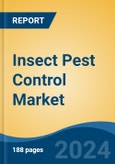Residential is the fastest growing segment, Asia-Pacific is the largest market globally
Speak directly to the analyst to clarify any post sales queries you may have.
10% Free customizationThis report comes with 10% free customization, enabling you to add data that meets your specific business needs.
Key Market Drivers
Increased public understanding and governmental focus on mitigating illnesses such as dengue, malaria, and Zika, transmitted predominantly by insects, are leading to heightened demand for comprehensive insect management strategies across residential, commercial, and public health sectors. For instance, according to the World Health Organization (WHO), in August 2025, the number of dengue cases reported globally increased to 14.6 million in 2024, illustrating the escalating threat and the necessity for robust vector control.Key Market Challenges
Stringent environmental regulations and protracted product approval processes represent a substantial impediment to the growth of the Global Insect Pest Control Market. These complexities significantly escalate the financial burden on companies involved in developing novel pest control solutions. Substantial research and development costs are incurred over extended periods as developers navigate an intricate web of regulatory requirements before a product can even be considered for market entry.Key Market Trends
The expansion of biological control methods reflects a growing preference for eco-friendly pest management alternatives, reducing reliance on synthetic chemicals. This shift is particularly evident in agriculture, driven by consumer demand for organic products and stringent environmental regulations. According to the Food and Agriculture Organization (FAO), global organic agricultural land reached 75.8 million hectares in 2023, with biological pest control consistently employed as a standard component within these production systems. Further illustrating this trend, according to Syngenta, in 2025 the company opened a 22,000 m² biologicals facility in Orangeburg, South Carolina, purpose-built to produce 16,000 tons of biostimulants annually. This investment highlights the industry’s commitment to scaling nature-derived solutions.Key Market Players Profiled:
- FMC Corporation
- Syngenta Crop Protection AG
- BASF SE
- Ecolab USA Inc.
- Rollins, Inc.
- Brown Gibbons Lang & Company
- ADAMA Agricultural Solutions Limited
- Sumitomo Chemical Company Limited
- Rentokil Initial plc
Report Scope:
In this report, the Global Insect Pest Control Market has been segmented into the following categories:By Type:
- Insect
- Termites
- Rodents
- Others
By Application:
- Residential
- Commercial
- Industrial
By Method:
- Chemical
- Mechanical
- Biological
By Region:
- North America
- Europe
- Asia Pacific
- South America
- Middle East & Africa
Competitive Landscape
Company Profiles: Detailed analysis of the major companies present in the Global Insect Pest Control Market.Available Customizations:
With the given market data, the publisher offers customizations according to a company's specific needs. The following customization options are available for the report:- Detailed analysis and profiling of additional market players (up to five).
This product will be delivered within 1-3 business days.
Table of Contents
Companies Mentioned
- FMC Corporation
- Syngenta Crop Protection AG
- BASF SE
- Ecolab USA Inc.
- Rollins, Inc.
- Brown Gibbons Lang & Company
- ADAMA Agricultural Solutions Limited
- Sumitomo Chemical Company Limited
- Rentokil Initial plc
Table Information
| Report Attribute | Details |
|---|---|
| No. of Pages | 185 |
| Published | November 2025 |
| Forecast Period | 2024 - 2030 |
| Estimated Market Value ( USD | $ 18.37 Billion |
| Forecasted Market Value ( USD | $ 26.99 Billion |
| Compound Annual Growth Rate | 6.6% |
| Regions Covered | Global |
| No. of Companies Mentioned | 9 |









